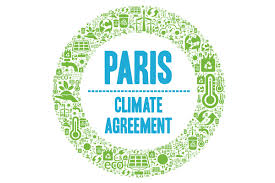The Paris Agreement
ENVIRONMENTAL ISSUES
Danny Xu
10/31/20253 min read


In December 2015, almost every nation was in Paris to sign one of the most crucial environmental agreements in the history of the planet – The Paris Agreement. It was the world's acknowledgment that climate change is a global crisis and that collective action is necessary to deal with it, but what exactly is the Paris Agreement and why is it so significant?
What is the Paris Agreement?
The Paris Agreement is a non-negotiable international agreement reached within the United Nations Framework Convention on Climate Change (UNFCCC). The agreement was unanimously adopted by 196 countries during COP21 in Paris and came into effect in November 2016.
It has an essentially straightforward but challenging objective: to limit the global temperature increase to less than 2 degrees Celsius compared to the pre-industrial era, while making efforts to keep the increase below 1.5 degrees. Otherwise, climate catastrophe could happen rapidly and irreversibly. Every country is required to present its own climate goal, called Nationally Determined Contributions (NDC), which should be updated every five years to make sure more ambitious goals are set.
Core Aspects of the Conference Page
One key factor that makes the Paris Agreement strong is the flexibility it sets. Countries have the liberty to map out their climate change plans according to their national situations while simultaneously moving toward the shared world goal. Accountability is another vital element of the Paris Agreement. It mandates countries to report the emission levels and progress periodically. Even though there are no strict punishments for those countries that fail to meet their targets, the transparency system is designed in such a way as to make peer pressure and trust among countries possible.
The agreement also mainly relies on offering moral support to the developing countries. Wealthier countries accepted the obligation of financing at least USD 100 billion annually for climate-related projects in developing countries that included adaptation to climate impacts and change to clean energy. This recognition makes it mandatory for those who contributed most to the problem to provide the most solutions.
Why the Paris Agreement Matters
The Paris Agreement is a major step in addressing global warming as it is the most consolidated global response to climate change. It used to be the case that international negotiations before 2015 were often on hold because the developed and the developing countries disagreed. Paris altered this.
Another reason why the Paris Agreement is important is that it acts as a strong supporter for other sectors besides government policies. Business community, investors, and local governments realize the transition to a low-carbon economy is unavoidable. Since this agreement, renewable energy projects have multiplied and companies all over the globe are making zero-emission commitment.
Progress and Challenges
The Paris Agreement is already influencing. A number of countries have either increased renewables, closed down their coal-fired power plants, or made investments in the electric vehicle sector. The very concept of "net-zero emissions" by the middle of the twenty-first century has gone beyond the walls of the conference and is now a familiar term even for laymen, with a multitude of nations having adopted long-term targets.
Yet, some obstacles remain. In terms of the 1.5-degree target, the current promises made are not enough and worldwide emission of greenhouse gases is still increasing. Some countries find it difficult to cut their carbon because of resistances to politics or lack of money. Notably, rich countries have also found it hard to keep their promises about the amount of money they would provide for the fight against climate change in less developed countries, which has led to the latter being more vulnerable. The example of the United States temporarily leaving under the Trump administration is just one among many that illustrate how delicate the global cooperation system is.
Conclusion
The Paris Agreement is a testimony to the power of human will when it is directed towards a common good. It is neither the be-all-and-end-all solution to climate change nor a stumbling block, but rather a very important initial step for united global actions. By aggregating nearly 200 nations under one umbrella and laying out clear and precise targets, it has permitted humanity to avoid the worst possible outcomes of climate change.
Whether or not that opportunity will be taken depends on the decisions we make right now. From world leaders to local communities to individual households, everyone has a role in making the Paris vision come true. It is through the agreement that we are reminded that climate change is not a problem that any one nation can solve alone, but collective action is the most potent weapon in our arsenal.
Sources:
UNFCCC. 2025. “The Paris Agreement.” United Nations Climate Change. 2025. https://unfccc.int/process-and-meetings/the-paris-agreement.
European Council. 2015. “Paris Agreement on Climate Change.” Consilium. 2015. https://www.consilium.europa.eu/en/policies/paris-agreement-climate/.
Hu, Shelia. 2025. “Paris Climate Agreement: Everything You Need to Know.” NRDC. Natural Resources Defense Council. January 23, 2025. https://www.nrdc.org/stories/paris-climate-agreement-everything-you-need-know.
